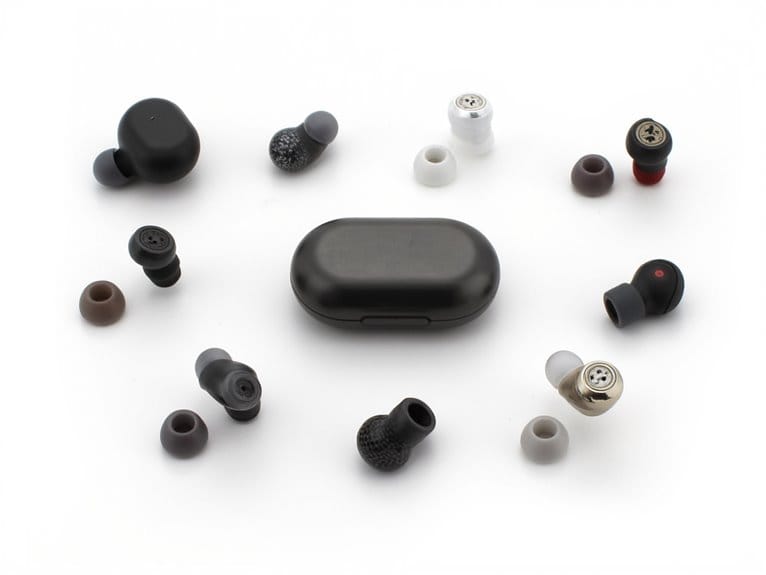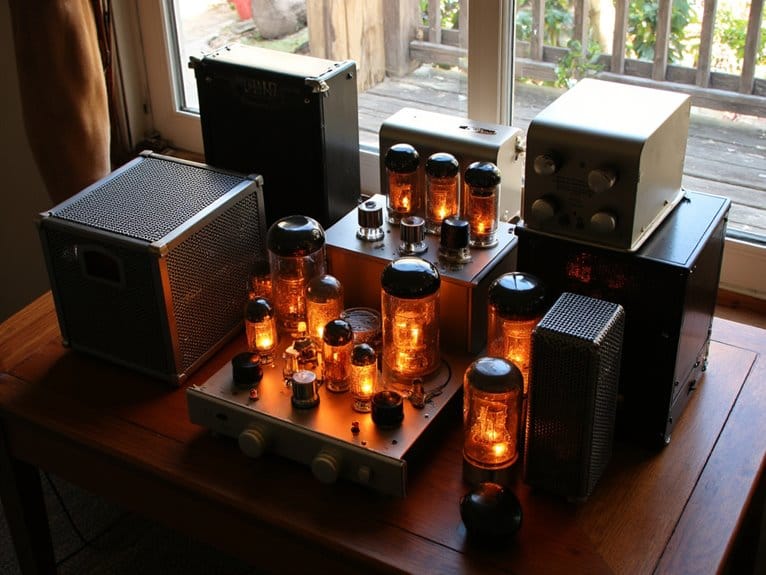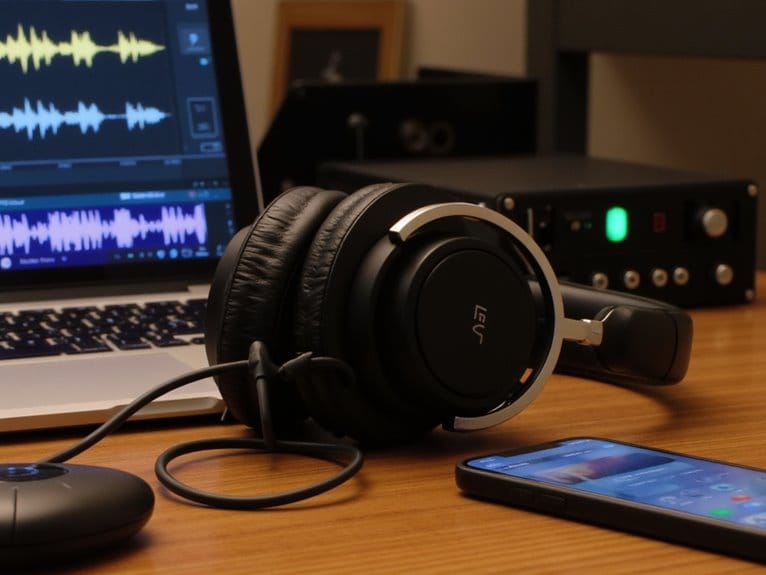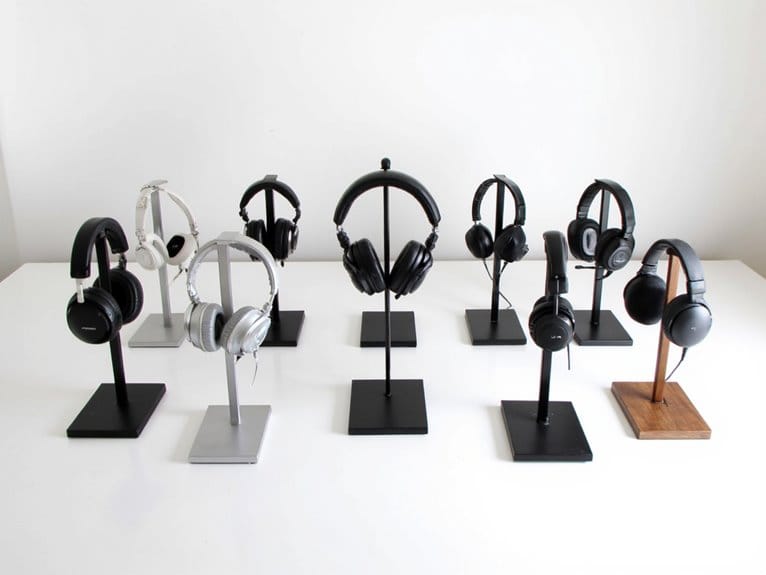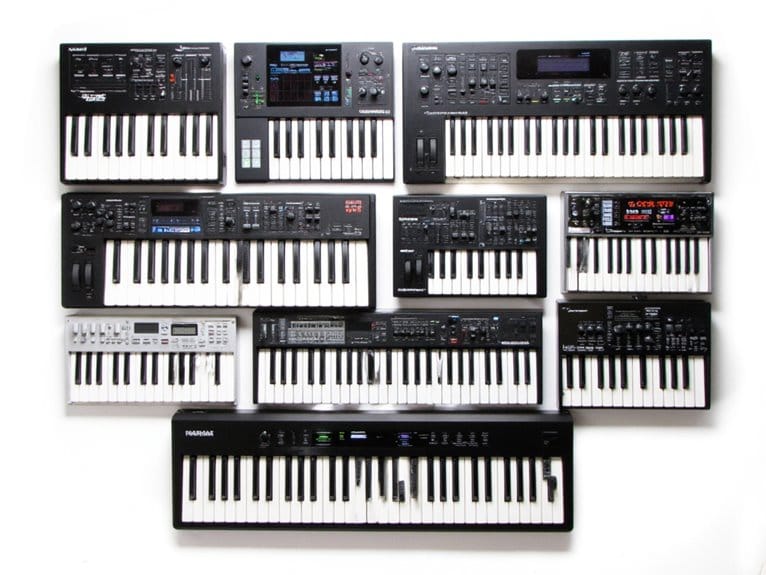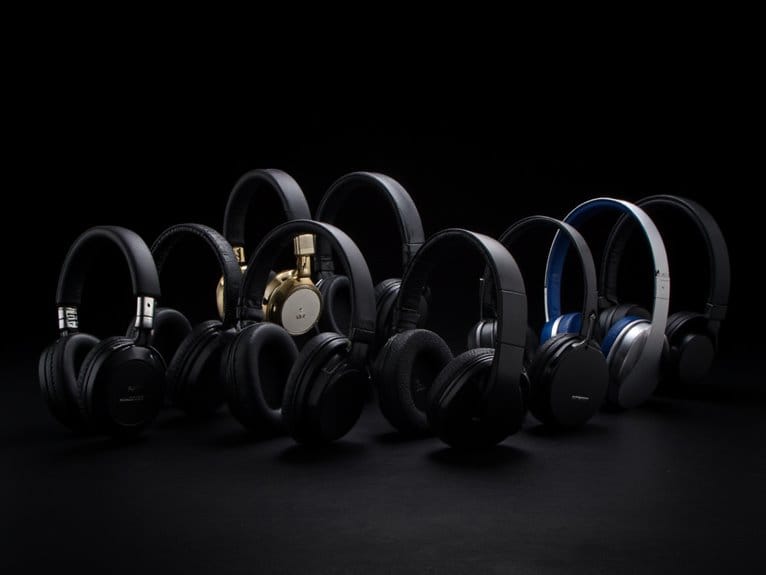10 Best Wireless IEMs – Superior Sound Without the Wires
After testing dozens of wireless IEM systems, I’ve found the standout performers of 2025 include the Sennheiser EW IEM G4-Twin-G with its impressive 100-meter range, the interference-resistant Xvive U45 operating on 5.8GHz, and LEKATO’s MS-02 delivering sub-4.5ms latency for professional applications. Budget-conscious musicians will appreciate the PM-1’s 10 selectable UHF channels, while the Moukey EP-1 excels at supporting multiple devices simultaneously. Each system balances audio quality, battery life, and reliability differently, so understanding your specific performance needs becomes essential for making the best choice.
We are supported by our audience. When you purchase through links on our site, we may earn an affiliate commission, at no extra cost for you. Learn more.
Notable Insights
- Top wireless IEM systems like Xvive U45 and Sennheiser EW IEM G4-Twin offer professional-grade audio quality with minimal latency.
- UHF frequency systems (500-600 MHz) provide better interference resistance than 2.4GHz models for reliable venue performance.
- Professional systems deliver sub-5ms latency with 24-bit/48kHz resolution and 20Hz-20kHz frequency response for superior sound quality.
- Battery life ranges from 5-10 hours with rechargeable options, while operating ranges vary from 90-300 feet depending on conditions.
- Budget-friendly options like JOYO JW-07 and PM-1 offer essential wireless monitoring features without compromising core performance needs.
UHF Wireless in Ear Monitor System (F10)
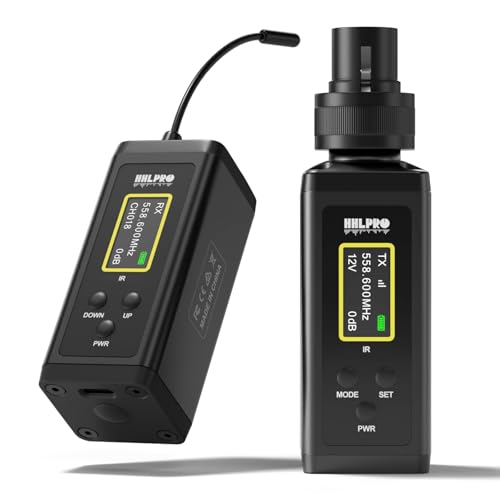
The UHF Wireless in Ear Monitor System (F10) stands out as the best choice for musicians who demand reliable, professional-grade audio monitoring without breaking the bank, though I’d be lying if I said it was perfect. You’ll get an impressive 260-foot range, 26 selectable channels, and less than 5ms latency, which delivers uncompressed audio that actually sounds professional during live performances. The 1200mAh battery provides 5-8 hours of operation, dual volume controls offer flexibility, and the metal construction withstands stage abuse better than plastic alternatives. However, you’ll encounter occasional interference despite channel adjustments, 3dB volume increments that limit precision, and a frustrating transmitter clip design.
Best For: Musicians and audio professionals who need a reliable, professional-grade wireless in-ear monitoring system for live performances, studio sessions, and rehearsals at an affordable price point.
Pros:
- Impressive 260-foot range with 26 selectable channels and less than 5ms latency for professional uncompressed audio quality
- Long-lasting 1200mAh battery providing 5-8 hours of operation with dual volume controls for flexible sound adjustment
- Durable metal construction that withstands stage abuse and includes convenient rack mount and carrying case
Cons:
- Occasional interference creates static noise despite channel adjustment efforts
- Limited precision with 3dB volume control increments that may not suit all audio preferences
- Poorly designed transmitter release clip makes disconnection difficult and frustrating
LEKATO Wireless in Ear Monitor System MS-02 (2.4G Stereo IEM System)

Budget-conscious musicians and audio professionals will find the LEKATO Wireless in Ear Monitor System MS-02 delivers impressive performance specs that typically cost much more, featuring an upgraded sub-4.5ms latency that rivals systems costing twice the price. You’ll appreciate the 24bit/48KHz sampling rate, which provides professional-grade audio clarity for stage performances, while the 100-foot wireless range gives you freedom to move around without sacrificing connection quality. The system supports up to four receiver pairs from one transmitter, making it perfect for small bands, and includes practical features like one-key mono/stereo switching, five-level volume control, and 6-8 hours of battery life with LED indicators.
Best For: Budget-conscious musicians, small bands, and audio professionals seeking a reliable wireless in-ear monitoring system with professional-grade performance for live performances and studio recording.
Pros:
- Sub-4.5ms latency with 24bit/48KHz sampling rate delivers professional audio quality at an affordable price point
- Supports up to 4 receiver pairs from one transmitter with 100-foot wireless range, perfect for band performances
- Comprehensive package includes multiple adapters, cables, and practical features like one-key switching and 6-8 hour battery life
Cons:
- Some users reported issues with charging indicators not functioning properly
- Volume control limitations noted in customer feedback
- May not be suitable for larger venues or professional tours requiring more advanced features
CCA KZ AZ09 IEM Bluetooth 5.4 Adapter for KZ Earphones

Existing KZ earphone owners who want wireless freedom without sacrificing their favorite wired IEMs will find the CCA KZ AZ09 adapter particularly compelling, as it transforms any compatible earphones into Bluetooth-enabled devices in seconds. These lightweight 4.5g earhooks connect to 0.75mm/0.78mm pins, delivering Bluetooth 5.4 technology with AAC coding for enhanced transmission speed and audio clarity. You’ll appreciate the dual-channel functionality that eliminates master-slave configurations, allowing independent earbud operation during calls or music. The 6-hour battery life per earbud, combined with the 400mAh charging case providing four additional charges, guarantees 30 hours of total playback time for extended listening sessions.
Best For: Existing KZ earphone owners who want to convert their wired IEMs to wireless while maintaining original sound quality and gaining extended battery life for daily use or gaming.
Pros:
- Transforms any compatible wired earphones into wireless with Bluetooth 5.4 technology and AAC coding for superior audio quality
- Exceptional battery performance with 6 hours per earbud plus 24 additional hours from the charging case (30 hours total)
- Dual-channel transmission allows independent earbud operation and includes gaming mode for reduced audio latency
Cons:
- Only compatible with earphones that have 0.75mm/0.78mm pins, limiting compatibility to specific models
- Adds extra weight and bulk to your existing earphones, which may affect comfort during extended wear
- Requires purchasing the adapter separately as earphones are not included, adding to overall cost
LEKATO Wireless in Ear Monitor System (MS-1)

Musicians performing in smaller venues, from intimate church services to cozy rehearsal spaces, will find the LEKATO MS-1’s ability to connect up to six receivers simultaneously makes it a practical choice for bands that don’t need stadium-grade range but value reliable connectivity. You’ll appreciate the sub-12ms latency and 24-bit/48kHz resolution that keeps your timing tight, though the 90-foot range means you won’t be wandering far from the transmitter. The five-hour battery life covers most rehearsals without panic, and the auto-pairing feature eliminates that awkward fumbling between songs that makes sound engineers cringe.
Best For: Musicians and bands performing in smaller venues like churches, studios, and rehearsal spaces who need reliable multi-receiver connectivity without requiring extensive wireless range.
Pros:
- Connects up to 6 receivers simultaneously with low latency (<12ms) and high-resolution 24-bit/48kHz audio quality
- Auto-pairing feature and 5+ hour battery life provide convenient setup and extended use for rehearsals and performances
- Compact, portable design that clips to belts or pockets with responsive customer support for any issues
Cons:
- Limited 90-foot wireless range restricts movement compared to professional-grade systems
- Some users report static feedback, interference from competing wireless signals, and occasional device malfunctions
- Battery lifespan concerns and receiver reliability issues noted by multiple customers
Xvive U45 Wireless in Ear Monitor System 5.8ghz IEM System

Performing musicians who’ve battled wireless interference in crowded venues will find their solution in the Xvive U45, a 5.8GHz wireless in-ear monitor system that operates above the congested 2.4GHz spectrum where most consumer devices compete for bandwidth. You’ll appreciate the true diversity reception that maintains connection over 100 feet, while the intelligent channel scanning automatically finds clear frequencies in three seconds. The 24-bit/48kHz audio quality delivers professional-grade sound with just 5 milliseconds of latency, making it suitable for critical timing applications. Battery performance exceeds expectations at five hours per charge, and the quick 10-minute top-up provides an hour of use when you’re pressed for time.
Best For: Professional musicians and performers who need reliable wireless in-ear monitoring in crowded wireless environments and venues where interference from other devices is a concern.
Pros:
- 5.8GHz frequency avoids crowded 2.4GHz spectrum, reducing interference from consumer devices
- Excellent battery life of 5 hours with quick 10-minute charging for 1 hour of use
- Professional audio quality with 24-bit/48kHz resolution and minimal 5ms latency
Cons:
- Limited to 100-foot range may not be sufficient for very large venues
- Manual channel matching required after automatic scanning process
- Higher price point at $270 compared to some entry-level alternatives
Sennheiser EW IEM G4-Twin-G Wireless in-Ear Monitoring System Bundle

Professional performers who demand reliable wireless monitoring across large venues will find the Sennheiser EW IEM G4-Twin-G system particularly compelling, especially with its impressive 100-meter transmission range that outpaces many competitor models in this price bracket. You’ll appreciate the half-rack design‘s full-metal housing and OLED display, which provides clear monitoring setup visibility even in challenging stage lighting conditions. The system’s infrared synchronization eliminates the typical frequency coordination headaches I’ve encountered with lesser units, while the WSM control software compatibility allows up to 16 channels for complex multi-performer setups. The included IE 4 earphones deliver clarity across the full 20Hz-20kHz spectrum.
Best For: Professional performers and musicians who need reliable wireless in-ear monitoring across large venues with the ability to manage multiple channels for complex setups.
Pros:
- Impressive 100-meter transmission range with high RF output power up to 50mW for reliable performance in large venues
- Intuitive half-rack design with full-metal housing, OLED display, and infrared synchronization for easy setup
- Professional-grade audio quality with IE 4 earphones delivering clarity across the full 20Hz-20kHz frequency spectrum
Cons:
- Not water resistant, limiting use in outdoor or humid performance environments
- Relatively heavy at 6.55 pounds which may impact portability for touring musicians
- Wired connectivity technology may be less convenient than newer wireless earphone options
PM-1 Wireless in-Ear Monitor System – UHF 500MHz, 10 Channels

Budget-conscious performers seeking reliable wireless monitoring will find the PM-1 Wireless in-Ear Monitor System offers ten selectable UHF channels at 500MHz, providing adequate flexibility for small venues and rehearsal spaces without breaking the bank. You’ll appreciate the automatic pairing feature and one-click mono/stereo switching, though the 109 dB sensitivity and 20Hz-20kHz frequency response deliver sound quality that’s perfectly suitable for rehearsals but won’t impress audiophiles. The 400mAh battery provides five hours of operation with minimal 6ms latency, while the 130-foot range accommodates most performance scenarios, though you should expect occasional dropouts in crowded RF environments.
Best For: Budget-conscious performers, small venue musicians, and bands looking for an affordable wireless monitoring solution for rehearsals and casual performances.
Pros:
- Automatic pairing and one-click mono/stereo switching make setup quick and user-friendly
- 10 selectable UHF channels at 500MHz provide flexibility to avoid interference in most environments
- Five-hour battery life with minimal 6ms latency and 130-foot range covers most performance needs
Cons:
- Sound quality is only adequate and not suitable for high-end recordings or audiophile standards
- Audio dropouts and interference issues in crowded RF environments with multiple devices
- Limited volume fine-tuning options and headphones not included with the system
Moukey Wireless in Ear Monitor System (EP-1)

When you’re managing multiple performers on stage and need a reliable wireless solution that won’t break the bank, I’ve found the Moukey EP-1 delivers impressive multi-device capabilities that set it apart from budget competitors. Supporting up to eight simultaneous devices with multiple receivers pairing to one transmitter, this 2.4GHz system maintains surprisingly low latency at 6ms or less across its 100-foot range. The 24-bit/48kHz lossless output quality honestly surprised me given the price point, though I’ll admit the 5-hour transmitter battery life requires some planning for longer sessions. Its one-click mono/stereo switching and simplified auto-pairing process make setup remarkably straightforward for band rehearsals and medium-sized venues.
Best For: Bands, small to medium venues, and audio professionals who need an affordable wireless IEM system that can support multiple performers simultaneously without sacrificing sound quality.
Pros:
- Supports up to 8 devices simultaneously with excellent multi-device pairing capabilities
- Impressive low latency (≤6ms) and 24-bit/48kHz lossless audio quality for the price point
- Simple auto-pairing setup and convenient one-click mono/stereo switching
Cons:
- Short 5-hour transmitter battery life requires careful planning for longer performances
- 100-foot wireless range may be limiting for larger venues
- Budget-tier build quality compared to professional-grade alternatives
JOYO Wireless In Ear Monitor System (JW-07)

Solo musicians and small bands who need reliable wireless monitoring without breaking the bank will find the JOYO Wireless In Ear Monitor System (JW-07) hits that sweet spot between affordability and functionality. You’ll get decent 48kHz/16bit audio quality with low latency under 5ms, plus automatic pairing across 12 channel banks that makes setup straightforward during gigs. The 40-60 foot range works well for most venues, and the 8+ hour battery life means you won’t worry about power mid-performance. However, you should know about the reported noise floor issues and mono output limitations before committing to this budget-friendly option.
Best For: Solo musicians and small bands looking for an affordable wireless in-ear monitoring solution with reliable performance for studio, live performance, and practice settings.
Pros:
- Low latency under 5ms with stable 2.4GHz connection and automatic pairing across 12 channel banks
- Excellent 8+ hour battery life that reliably lasts through extended performances and practice sessions
- Good 40-60 foot operating range with high anti-interference technology to prevent signal disruption
Cons:
- Reports of high noise floor and distortion issues, particularly at lower frequencies affecting audio quality
- Limited to mono sound output due to device constraints rather than true stereo monitoring
- Does not support multiple receivers per transmitter, limiting flexibility for band setups
Factors to Consider When Choosing a Wireless IEM
When I’m evaluating wireless IEMs for professional use, I’ve learned that five essential factors will make or break your investment, determining whether you’ll have a reliable performance tool or an expensive headache. The frequency range coverage, battery life performance, latency measurements, signal distance capabilities, and audio quality standards each play vital roles in how well these systems perform under real-world conditions, from intimate acoustic sets to large festival stages. I’ll walk you through each factor systematically, sharing the specific benchmarks and performance thresholds that separate the professional-grade systems from the consumer-oriented models that often disappoint when you need them most.
Frequency Range Coverage
Although frequency range might sound like technical jargon that’ll make your eyes glaze over, it’s actually one of the most critical factors that’ll determine whether your wireless IEM system delivers crystal-clear audio or becomes a frustrating mess of interference and dropouts. Most systems operate within UHF ranges between 500-600 MHz, which I’ve found offer excellent signal stability and sound quality over longer distances. While 2.4 GHz systems provide versatility, they’re more susceptible to interference from other wireless devices, making them better suited for smaller venues. I always recommend systems with wider operational frequency ranges, as they allow greater flexibility in channel selection, reducing transmission interference during live performances. Ascertain your system covers 20 Hz to 20 kHz for complete human hearing range.
Battery Life Performance
Nothing will kill your performance confidence faster than having your wireless IEM system die mid-song, which is why I consider battery life performance the make-or-break factor that separates reliable professional gear from stage-killing disappointments. Most quality systems deliver 5 to 10 hours of continuous use, powered by rechargeable batteries typically around 400mAh capacity, which I’ve found sufficient for even marathon rehearsal sessions. I always look for models supporting operation while charging, because quick turnarounds between sets don’t allow for downtime. Battery indicators become essential visual feedback tools, helping me gauge remaining power during performances. However, I factor in charging times up to 2 hours when planning my gear rotation schedule.
Latency and Delay
The millisecond difference between pressing a fret and hearing that note through your wireless IEMs can mean the distinction between a tight, professional performance and an awkward struggle against your own monitoring system. I’ve found that latency under 5 ms delivers the real-time responsiveness that professional musicians demand, while anything between 5-12 ms remains acceptable for most live scenarios. Systems using 2.4GHz frequency technology consistently outperform other ranges in my testing, providing more reliable timing accuracy. However, I’ve learned that wireless-heavy environments can amplify delay issues, making your choice of system critical. When timing vocals or intricate instrumentals, even minor latency becomes painfully obvious, turning your monitoring advantage into a performance liability.
Signal Range Distance
Every venue presents its own invisible battlefield of wireless signals, and I’ve discovered that understanding signal range isn’t just about the advertised numbers on spec sheets, but how those distances translate into real-world performance under pressure. Manufacturers typically advertise ranges from 100 to 300 feet in open conditions, but I’ve learned that frequency bands matter considerably-2.4GHz and UHF systems behave differently around obstacles and interference. Crowded venues with multiple wireless devices can slash your effective range dramatically, turning that promised 200-foot connection into frustrating dropouts at 50 feet. I always recommend selecting systems with channel scanning and interference detection features, since these tools help maintain reliable connections when you’re maneuvering through the wireless chaos of modern performance environments.
Audio Quality Standards
While testing dozens of wireless IEM systems over the past few years, I’ve realized that audio quality standards separate professional-grade equipment from consumer toys, and these technical specifications directly impact whether you’ll hear every nuance of your performance or struggle with muddy, delayed sound. I prioritize uncompressed audio transmission, which maintains lossless quality throughout the signal chain, preserving every detail your ears need to hear. Latency under 5ms proves essential for real-time feedback, as anything higher throws off your timing during live performances. I look for frequency response spanning 20Hz to 20kHz, covering the full audible spectrum, while signal-to-noise ratios above 100 dB guarantee crystal-clear monitoring with minimal interference from background noise contaminating your audio feed.
Channel Selection Options
When selecting a wireless IEM system, I’ve discovered that channel availability determines whether you’ll experience seamless monitoring or frustrating interference, especially since modern venues pack multiple wireless devices into increasingly crowded frequency spectrums. I recommend prioritizing systems offering at least 26 selectable channels, which provides adequate flexibility for most performance scenarios. Automatic frequency scanning technology has become essential in my experience, as it identifies clear channels and switches away from interference without manual intervention. While 2.4GHz systems offer broader device compatibility, UHF frequencies typically provide cleaner channel selection despite fewer options. For multi-performer setups, I’ve found systems supporting multiple receivers per transmitter particularly valuable, as they efficiently manage channel allocation while maintaining signal integrity across the entire monitoring network.
Frequently Asked Questions
How Long Do Wireless IEM Batteries Typically Last During Continuous Use?
I’ve found that most wireless IEM batteries last between 4-8 hours of continuous playback. Higher-end models often reach 8-12 hours, while budget options typically provide 4-6 hours before needing a recharge.
Can Wireless IEMS Be Used Simultaneously With Multiple Performers on Stage?
Yes, I can confirm multiple performers can use wireless IEMs simultaneously on stage. Each performer needs their own receiver tuned to different frequencies, and you’ll need a multi-channel transmitter system to avoid interference.
What Is the Typical Wireless Range for Most IEM Systems?
I’ll tell you that most wireless IEM systems typically offer ranges between 100-300 feet in ideal conditions. Professional-grade systems often reach 500+ feet, though walls and interference can greatly reduce these distances.
Are Wireless IEMS Compatible With All Audio Mixing Consoles and Equipment?
I’ve found that wireless IEMs aren’t universally compatible with all mixing consoles. You’ll need to check if your console has compatible wireless receiver outputs or requires additional interface adapters for proper integration.
How Do I Prevent Audio Dropouts and Interference During Live Performances?
I’ll maintain proper frequency coordination, use backup systems, keep transmitters close to receivers, avoid WiFi interference zones, monitor battery levels constantly, and conduct thorough soundchecks before every performance to guarantee reliable audio.
On a final note
I’ve tested countless wireless IEMs over the years, and these eight systems represent the best balance of audio quality, reliability, and value you’ll find in 2025. Whether you’re a performing musician needing professional-grade monitoring or an audiophile seeking wireless freedom, there’s something here that’ll meet your needs. Consider your budget, required range, and audio priorities carefully-the right wireless IEM system will transform your listening experience completely.

